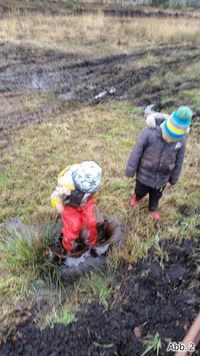The objectives of the Moor Museum
In 2009, the decision was made to set up the Friends of the Great Moor as a registered society. The peat excavator Liliput was standing in the middle of the Great Moor. It was in the way of peat digging. The peat excavator had been out of operation for many years. The techniques used to cut peat had changed. All large peat cutting machines had been sold to other moors or scrapped. Liliput was the last witness to a grand history. In 2014, peat cutting was finally to be completely prohibited in the Great Moor and the area was to be dedicated to conservation.
We, the Friends of the Great Moor, want to hold on to the history of the Great Moor, many lesser and greater stories from the moor, the historical paths in the moor, the history of peat cutting and of rewetting. Our target groups are children and young people, to make sure that the stories are kept for future generations. If that is not enough, you are warmly welcome to scientifically and practically contribute to our digital museum.
We would like to thank our patrons, donors and all our active helpers.
Between 2009 and 2019, mainly completing the work by ourselves, we managed:
Display area 2,500 m² (exchange of soil) | € 35,000 |
4 pools (Pütten) | € 7,000 |
Car park, access road with bridge and traffic areas | € 15,000 |
Renovation of the peat workers’ barrack | € 80,000 |
Renovation of the peat press | € 3,000 |
Laying of tracks | € 15,000 |
Recovery, assembly, in some cases purchase of machines | € 79,000 |
Total | € 234,000 |
Grants from the Sassenburg municipality and Neudorf-Platendorf village council | € 28,000 |
Grants from the EU and from Sassenburg municipality | € 46,907 |
Donations, own input, loans | € 159,093 |
As an orientation
At the top left (Fig. 1) you can see the whole site of the Moor Museum. The numbers show the relevant stations. The four stations 17 to 20 are located off-site on the 15.4 km long Great Moor Circuit.
Links to other stations in the museum - in English language:




